Foreword: I would like to dedicate this post to my dear friend, Emily, who very much wants to catch this very exhibition that I am going to write about. I hope she can soon find the time to catch this exhibition.
**
Last Sunday, I have made a special trip down to the Asian Civilisation Museum (Singapore) just to catch the exhibition titled Mystery Men: Finds from China's Lost Age.
As a ardent supporter of the museum's guided tours, I would recommend all laymen, like myself, to hop onboard one of the guided tours to this particular exhibition. The guided tour would help lend one a good overview to the exhibits in this exhibition in a duration of about an hour. The schedules of the guided tours to Mystery Men: Finds from China's Lost Age can be found here: http://www.acm.org.sg/visitus/guidedtours.asp)
Prior to attending the guided tour, I decided to check out the exhibition first. I was fairly impressed by the exhibits at the exhibition. I could sense that the curators have put in much thought and care in curating this exhibition.

Shortly later, I joined in one of the guided tours. During the guided tour, I found out from the guide who was leading the guided tour that I was onboard, that it took about four years of behind-the-stage work (from obtaining approval from the authorities in China, to planning, etc) to make this exhibition a reality. When I heard that, I felt thankful to the many people who have worked behind-the-scene. Their efforts have paid off finally.
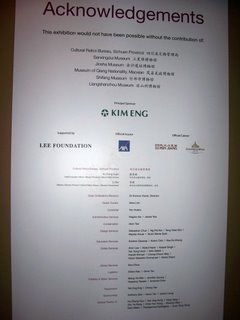

What is so special about this exhibition? If I try hard to be a history bluff, I shall say that in this exhibition I can get an experience of what early Chinese civilisation could be like. But it was more than that. I read from one of the brochures on this exhibition that a discover made in 1986 challenges the widely accepted view of the Yellow River Basin as the cradle of early Chinese civilisation.
And since anyone would have figured that I am trying hard to be a history bluff, I shall make my life easier by quoting from one of the exhibition's publicity brochures that writes about the discovery that is closely related to this exhibition:
In 1986, brickyard workers in Sichuan made an amazing discovery. They came across a sacrificial pit which was filled with elephant tusks, bronze human heads, ceremonial jades and gold. Fantastic-looking masks – some with protruding pupils, large ears and attachments to the forehead – were excavated and found to have been made some 3,200 years ago. The site known as Sanxingdui was to challenge all previous understanding of early Chinese civilisation. (view source)
While I was at the exhibition, my mind was working very hard to answer the many questions that struck me. What is Sanxingdui? It turns out that Sanxingdui is the name of the location of the two sacrificial pits in which the masks were found. Geographically, Sanxingdui is located about 40 km from Chengdu, the capital of Sichuan province. At the exhibition, one can find out a little more about the people who used to live in ancient Sanxingdui. In short, scholars have agreed that the people of the ancient city of Sanxingdui were of Shu origin.
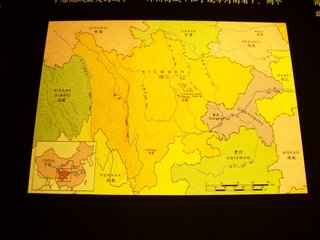
As best as I remember from the guided tour, the first sacrificial pit that was found was about 100 years earlier than the second sacrificial pit. I found it particularly interesting to learn about the differences in the objects between the two sacrificial pits. In addition, I particularly like reading the analysis on the conclusions that one can draw about the Sanxingdui society from the observed differences.
I very much like the concept of one part of the exhibition whereby the set-up attempted to make one feel as if one was right in one of the two pits. Please refer to the photo right below and visit that part of the exhibition if you were to go to this exhibition.

I also like the charts that show in a nutshell a summary of the items that were found in each of the two pits. I think the charts sum the discovery very well for a laymen like myself.

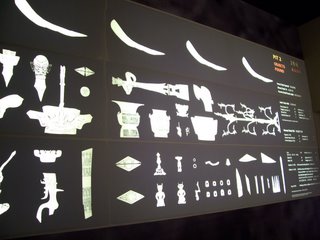
Interestingly, a number of elephant tusks have been found in both the sacrificial pits. I wondered: Were there elephants living in that part of China in those ancient times? If there were, what kind of climate was Sichuan like in those days? The tour guide made some comments that gave me some clues to the answers to my first question.
I realised that I cannot leave the exhibition without taking a good look at the masks of Sanxingdui. The masks are certainly unique with their protruding eyes. What do the protruding eyes symbolise? According to the description boards found next to the various exhibits, some have speculated that the eyes and ears could symbolise acute sight and hearing. Other scholars consider that the protruding eyes were to represent the rulers descended from one of the Shu king, Cancong.
If one were to be dead observant, one could notice that these masks have holes on them, and these holes appear to be there so that the masks could be hung up. What are these masks used for? That is a mystery for now.
Other than the masks, I could not help but also take notice of the bronze heads. I read from the plaques next to one of the exhibits that many Chinese scholars believed that the bronze heads found in the Sanxingdui pits represent shamans or tribal leader. What do you think these bronze heads may represent?
The bronze head below that was excavated from Sanxingdui Pit 1 is perhaps one of the more realistic looking heads that was found from the two Sanxingdui pits.
I could have a fascination looking for burnt marks on the exhibits. I was told that many of the objects found from the Sanxingdui pits show signs of being intentionally damaged. Some objects were broken intentionally while others were burnt before being buried. Is burning or breaking the items a way that the people of ancient Sanxingdui pay respect to their gods or ancestors?
At the exhibition, the tour guide also told us of two of the items found in the Sanxingdui pits which are not being exhibited in the exhibition. The good thing is that the curator has been thoughtful to include photographs of these two items for our viewing pleasure. For your convenience, please click on the two links right here to view photos of these two exhibits: Item 1: 青铜立人像, Item 2:青铜神树.
Birds and trees seem to have an important place to the people of ancient Sanxingdui. Please check out the exhibition to find out more.
There is a small section on the bronze casting technology of the Sanxingdui civilisation. I found it a little challenging for myself to fully understand the process in which the bronze works were being casted. It might have been better if there could be a video demonstration of the bronze casting process.
Other than items made from bronze, one can find items made from jade at this very exhibition. One of the exhibition's information boards noted that jade production is a complex process, and "the discovery of jade production in Sanxingdui speaks of a society with an established and highly developed artistry".
Deep in my mind, I am curious to find out what was the lifestyle and general cultural beliefs of those people of ancient Sanxingdui. What had motivated them to bury so many precious items in the ground, for religious, sacrificial purposes?
I found myself fairly keen on the exhibits that portray the kneeling poses of the people of Sanxingdui. It appeared that people from different societal classes kneel in different ways. Make a guess which one of the two kneeling poses found below could be adopted by the aristocrats.
Being interested in the roles that women had played in the ancient Sanxingdui society, I took special interest in the exhibit below. Yet, there wasn't much that I could infer from the exhibit other than the fact that women had existed in that society.
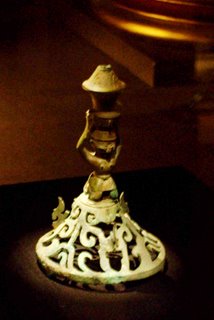
I heard that the people of ancient Sanxingdui would place cowrie shells (which were used as a form of currency in those days) in vessles like the ones below, bury the vessels as sacrifice to the gods. Those folks do seem rich. Maybe they could come up with some cultural practices that could better redistribute their wealth? Anyway, the shells were theirs and it should be up to them to decide what they wish to do with it. I can only imagine that these people of Sanxingdui revered their gods very much that they can give up anything for their gods.
The word Shamanism seemed to stuck on my mind after the end of the guided tour. But folks, if you want to know why, I suggest that you visit this exhibition. For one thing, I am not in anyway knowledgeable in the topic of Shamanism. I can only leave the readers with one photo of a related exhibit that had caught my eye.
What kind of society had lived in Sanxingdui more than three thousand years ago? What kind of worldview did the people in that civilisation have? I have more questions unanswered, and I can only keep my fingers crossed that one day, a scholar who has done extensive research on the Sanxingdui civilisation could fill me.
Meantime, there are more to see at the exhibition, and for a price of $8 per adult, one can save oneself from making a trip all the way to the Sanxingdui Museum in China, and yet still view similar exhibits. What could be more cost-effective?
So here's more information regarding this exhibition:
Mystery Men: Finds from China's Lost Age
16 Jan 2007 - 15 Apr 2007
Asian Civilisation Museum, Special Exhibitions Gallery
Opening hours of the museum:
Mon: 1 pm- 7pm
Tue-Sun: 9am-7pm (to 9pm on Friday)
***
References:
http://www.acm.org.sg/home/home.asp
http://www.acm.org.sg/exhibitions/eventdetail.asp?eventID=153
http://en.wikipedia.org/wiki/Cowrie
***
Recommended related external links to check out:
http://www.china.org.cn/e-sanxingdui
http://en.wikipedia.org/wiki/Sanxingdui
Sanxingdui Museum
Sanxingdui Museum, Chengdu Attractions, Sichuan Travel
http://www.springerlink.com/content/ww55jxhn4pjwux52/
Mystery Men unearthed!
***
Acknowledgements:
Special thanks to Shaun for helping me to obtain the clearance from Asian Civilisation Museum to post the photos of the exhibition. A word of appreciation to Asian Civilisation Museum for granting me the permission to post the photos.
Note: All photos above are taken using non-flash photography.
***
Update: There will be free admission to the Asian Civilisation Museum (inclusive of free admission to the Mystery Men exhibition on 19 Feb 2007. In addition, the museum will extend its opening hours from 18 to 20 Feb 2007. Details can be found here.




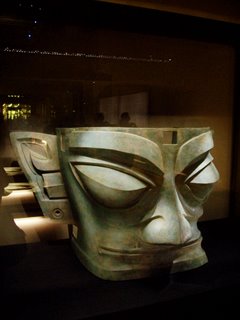










5 comments:
Peiyun, many thanks for dedicating this post to me. Dedications come as a very strong word in my dictionary and I am truly touched because I think I only mentioned it to you in passing.
I'll make it a point to go down soon. Tue/Thu 4pm guided tours. Seems like the guide is not bad.
I love museums! Many thankx =)
I was surprised to see that you could take photos in the museum. I see that you have clearance. What a hassle! Need to ask for permission before going down to take photos. Only you got the patience. I'm just a lazy bum. hehehe........
pei yun, thanks for this very thorough write up and sharing with us your take on the exhibition. No worries about seeking the approval, most happy to help out such an enthusiastic blogger as yourself.
Emily: My pleasure.
Eastcoastlife: Thanks to Shaun, it was much easier for me.
Shaun: Thank you very much for your help. That helps cut whatever red tape that I may have to face if I were to seek approval on my own.
Interesting article, you make some interesting points.
museum directory
Post a Comment